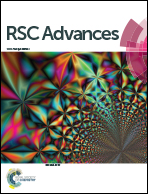Enhancement of emission intensity of Sr2Si5N8:Eu2+ red-emitting phosphor by localized surface plasmon resonance of Ag nanoparticles with different morphologies
Abstract
The emission intensity of commercial red Sr2Si5N8:Eu2+ phosphor, which is used in white light-emitting diodes (LEDs), was enhanced by coupling with the localized surface plasmon (LSP) oscillation of nano-structured (nano-spheres and nano-rods) Ag particles produced by a seed growth method. Coatings of Ag nanoparticles mixed with phosphors on an epoxy substrate were prepared. The experimental results showed that spectral overlap occurs between the LSP resonance band of Ag nanoparticles and the excitation and emission spectra of the phosphor. The emission intensity was enhanced (∼25%) by the synergistic effect of Ag nano-spheres and nano-rods mixed in optimal proportions. The produced phosphors improved the quantum efficiency of red phosphors, which is a very important feature in white LED systems.


 Please wait while we load your content...
Please wait while we load your content...